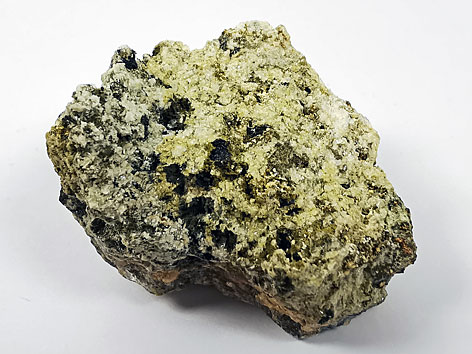
Kingsmountit xx neben Paravauxit xx, Mitridatit und Frondelit
Steinbruch Silbergrube, Waidhaus, Oberpfalz, Bayern, BRD
Stufe: 3,5 x 2,8 cm

Kingsmountit xx
Detail der oben abgebildeten Stufen
Bildbreite: 1,6 mm
|
Kingsmountit |
|
|
Formel: |
Ca3MnFeAl4(PO4)6(OH)4·12H2O (8.DH.25; Montgomeryit-Gruppe) |
|
Ausbildung: |
triklines Kristallsystem; weiß bis bräunlichweiß; tafelige (klingenförmige) Kristalle oder Fasern zu oft radialen bis kugeligen Aggregaten bis 2 mm Größe |
|
Entdeckung: |
IMA 1978-041; 1979 - Dunn & Peacor & White & Ramik; benannt nach dem Kings Mountain District, North Carolina, USA, in dem sich die Typlokalität befindet; 2019 neu definiert (IMA 19-B, Grey et al., neue Formel, triklines Kristallsystem) |
|
Typlokalität: |
USA, North Carolina, Cleveland Co., Kings Mountain District, Foote Mine (Foote Lithium Co. Mine) |
|
Seltenheit: |
selten (Mineralienatlas: 19 / Mindat: 16 Lokalitäten; 2024) |
 Kingsmountit xx neben Paravauxit xx, Mitridatit und Frondelit Steinbruch Silbergrube, Waidhaus, Oberpfalz, Bayern, BRD Stufe: 3,5 x 2,8 cm
|
 Kingsmountit xx Detail der oben abgebildeten Stufen Bildbreite: 1,6 mm
|
Quellen: Sammlung und Fotos Matthias Kahl; allg. Mineralbeschreibung nach Mineralienatlas.de, Mindat.org, Handbook of Mineralogy, DeWikipedia und/oder Lapis-Mineralienmagazin
© copyright Matthias Kahl